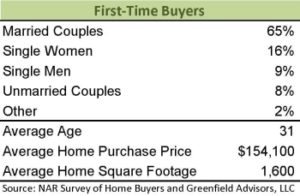Recently, The Seattle Times published an article discussing how U.S. home sales were at a 5-year high by the end of 2012.[1] Like any other citizen and particularly because we work in real estate, we were happy to hear this news. One aspect of the article that particularly caught our eye was the percentage of first-time homebuyers in the market. The article noted that in December 2012, only 30% of home sales were to first-time buyers, but in a typical or healthy market, it is usually 40%.

So what do we know about the 30% of first-time buyers who are purchasing homes? A recent survey from the National Association of Realtors (NAR) indicated that the average first-time homebuyer is 31 years of age.[2] This is actually a decrease in the average age of a first-time homebuyer from previous years. However, these younger buyers are purchasing smaller, more affordable homes than their predecessors. First-time buyers are also more likely to be single than first-time homebuyers of the past. Married couples still make up the largest portion of the first-time homebuyer market, particularly because a dual income makes it easier to meet today’s tougher lending requirements compared to pre-recession lending requirements.
The unemployment rate for individuals above 25 years of age was 4.9% in December 2012. This relatively low unemployment rate for the 25+ age group may be a contributing factor to the decreased average age of a first-time homebuyer. In contrast, the employment of recent college grads (those typically younger than 25) is well below normal. In fact, the Economic Policy Institute noted in May 2012 that the unemployment rate of those under 25 is twice as high as the national average unemployment rate.[3] In December 2012, the unemployment rate for recent college graduates with 4 year degrees was 8.2%.[4] This is the highest among all age groups.
Those individuals under 25 who can find a job are relatively lucky and often underemployed. A recent study by the Center for College Affordability and Productivity shows that around 48% of recent college graduates are working in jobs that do not require a college degree.[5] As such, it is not surprising to find that these individuals are earning lower incomes at these jobs than they would at a job that does require a college education. The real inflation-adjusted annual wages of college grads have declined by 5.4% since 2000.[3] At the same time, this demographic is facing the challenge of paying back some of the highest tuition rates and consequently some of the highest student loans in history.[6]
While first-time homebuyers are younger and more likely to be single than in the past, the combination of factors affecting the under 25 age group and other factors (most of which are economic) make the prospects of increasing the number of first-time buyers seem bleak. With banks now requiring homebuyers to provide a larger down payment and with tougher credit regulations than in the past, this may be increasingly difficult. One trend among first-time homebuyers is that they are more likely to use their savings for a larger down payment or pay all cash for their homes than first-time buyers of the past.[7] Another trend among recent first-time buyers is that they have a tendency to avoid extreme levels of debt compared to first-time buyers of the past.[8] This may partially explain the tendency for first-time buyers to now purchase homes that are of lesser value and smaller in size.
Or perhaps living within our means is the new American dream? A press release from Better Homes and Gardensindicated that 69% of Generations X and Y surveyed would buy a home after they can afford to maintain their current lifestyle.[8] In addition, 71% indicated that homeownership was not something they deserved, but rather something earned. The same survey also indicated that these generations were more likely to research buying a home. According to this survey, 69% also indicated that the recent housing downturn made them more knowledgeable about owning a home.
All said, two-thirds of recent graduates are paying back historically high student loans. While the outlook for recent college graduates is expected to improve, it may be a while before first-time home sales jump back to 40%.[4]
– Abigail Mooney and Sarah J. Kilpatrick






Recent Comments